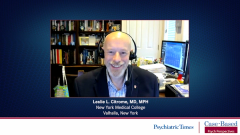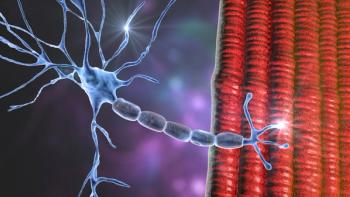
Managing Patients on Antipsychotic Therapy
In this custom video series, experts provide insight into strategies that may be helpful to healthcare professionals who manage patients on antipsychotic therapy to best monitor for signs of tardive dyskinesia, with special considerations regarding telepsychiatry.
Episodes in this series

Leslie L. Citrome, MD, MPH: Dr. Xavier, you pointed out that patients could have both drug-induced Parkinsonism and tardive dyskinesia [TD], which makes it challenging indeed to figure out what to do first. And my own opinion in that regard is drug-induced Parkinsonism is easier to deal with than tardive dyskinesia. With drug-induced Parkinsonism we can do things like lower the dose of the antipsychotic, change the antipsychotic. Let me ask you though, and this is a leading question Dr. Xavier, what about Cogentin [benztropine]? Would that work?
Rose Mary Xavier, PhD, MS, RN, PMHNP-BC: Well, Cogentin can make it worse if you treat, it’s an anticholinergic. If we use anticholinergic to treat tardive dyskinesia, the symptoms can be worse. It will work for the Parkinsonism symptoms, but it is not going to work for the TD. So you have to, again that goes back to making sure that you’re doing the differential for the type of movement condition. It is important to do the assessment. I just want to add a couple of points about the AIMS [abnormal involuntary movement scale] that you just mentioned though. You are right, it is very easy. Once you do it, it totally takes about 5 minutes. But the two components, like visually observing the patient before you do the test and making sure that the patient is sitting in a form chair with which doesn’t have any sidebar or handles, those things are critically important. But then the question comes, what if you are doing a telepsychiatry visit? Now how do you test for muscle rigidity? Now we know that from studies that have looked at administering AIMS in face-to-face assessment where it says at a telepsychiatry, the interrater reliability was actually very close. It was very similar. There was not much of a difference between raters who did face-to-face versus who observed. But the one thing is the muscle rigidity where the physician or the clinician assessed that, that is not included in the rating. You can skip if you want a televisit. But I think the most important thing if you are doing a televisit is to make sure that you have the network bandwidth. Because if it freezes or slows down and you are looking for a movement condition, then it can be very challenging.
Leslie L. Citrome, MD, MPH: Telepsychiatry has turned our world upside down, hasn’t it?
Rose Mary Xavier, PhD, MS, RN, PMHNP-BC: Yes.
Leslie L. Citrome, MD, MPH: Depending on it far more than we ever did before. Now I remember occasionally I would see patients or talk to them on the phone, only when I had to when they could not make it into the office, and then it became routine for a little while. And assessing for movements can be quite challenging on a little tiny screen on your phone. If you are going to do telepsychiatry and going to assess for motor abnormalities, you need to look at them on a bigger screen. And it’s helpful to have someone there with the patient holding the camera, holding the phone from a distance so you can get a better idea of how they look when they’re sitting, their whole body, how they’re walking, and the ability to record and zoom in on let’s say their face when you’re thinking, did I see something there? It is helpful to go back to the videotape so to speak and look at that face and see if that indeed was an abnormal movement that you detected in the jaw, for example. So it does require a little more preparation, but it is not impossible to do. The clinical trials that were done to develop the VMAT2 inhibitors for, and garnered FDA [Food and Drug Administration] approval, they all employed video ratings as their primary way of assessing the TD. So that meant that there were blinded video raters who were not aware of where the patient was during the clinical trial, what they were randomized to or anything, and they were able to examine them, so to speak, by reviewing a videotape. Now the videotape was done very carefully in a very well-lit studio, and that really optimized the conditions to where you can detect abnormal movements. We do not generally have that capability for our patients when we do telemedicine, but we can certainly improve our game by avoiding just looking at a little tiny phone screen. Now we do miss out on assessing rigidity. But the next best thing is assessing their gait and looking at their arm swing. That is very helpful. The other differentiation between drug-induced Parkinsonism and tardive dyskinesia that can be quite instructive is the timing on when these movements started. Now sometimes you do get this information in someone who is newly started on an antipsychotic, and this is the very first time they are on it, is very good information. If they started having an abnormal movement in the first couple of days, it is not tardive dyskinesia, it’s going to be some other movement disorder, and probably means that you need to switch the antipsychotic to something else. But if it emerges after a year or two, and they did not have any problems before then, we are going to be very suspicious of tardive dyskinesia. If we increase the dose of the antipsychotic, the drug-induced Parkinsonism would get worse, but the TD may get a little better. We have masked the TD to some extent. That can be helpful too in our differential. If we lower the dose of the antipsychotic, the drug-induced Parkinsonism should get better, but the TD may look a little worse. So those are some of the clues that we can get. And you had mentioned earlier, Dr. Xavier, about Cogentin not being helpful, benztropine not being helpful. It can make TD worse. It actually says that in its product label, not for TD. Can make TD worse. But let us say we make that mistake, and that we misjudge someone to havea drug-induced movement disorder that we think is drug-induced Parkinsonism. We give them benztropine and they get worse. Well, it is not the end of the world. We can stop the benztropine and we can think through this problem and think about tardive dyskinesia as the real culprit here. It can be instructive to see this because it can help us in the differential diagnosis.
Transcript edited for clarity.
Newsletter
Receive trusted psychiatric news, expert analysis, and clinical insights — subscribe today to support your practice and your patients.








